Top Ten List of Easy Care Corals for Reef Aquariums
A question we receive at least once a week is "Which corals are good for beginners?", or "How do I choose the best live coral for my new reef tank?". The fact is that many new reef tank hobbyists can be a bit reserved when it comes to dropping a large amount of money on corals that they really are not so sure about. To help put you at ease and to aide in your new live coral purchasing decisions, we've complied this top ten list of easy care corals for reef aquariums. Whether you are a beginner or an old salt, you'll find something on this list that is sure to please your aesthetics and make your tank look gorgeous. Get ready to enjoy some coral eye candy!
10. Open Brain Corals (Lobophyllia):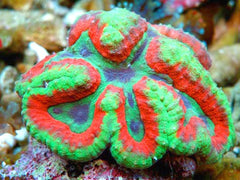 Also known as the Lobed or Flat Brain Coral, these corals respond well to direct bright light and low to moderate currents. Even under minimum adequate light and water movement, Open Brain Corals will almost always do well in a tank. Lobophyllia feeds at night, mostly on zooplankton. Colors vary from bright red, green, orange, gray, tan, or brown.
Also known as the Lobed or Flat Brain Coral, these corals respond well to direct bright light and low to moderate currents. Even under minimum adequate light and water movement, Open Brain Corals will almost always do well in a tank. Lobophyllia feeds at night, mostly on zooplankton. Colors vary from bright red, green, orange, gray, tan, or brown.
9. Closed Brain Corals (Symphyllia):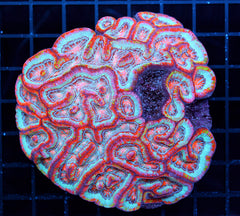 Also known as the Dented Brain Coral, Meat Coral, or just Brain Coral, these corals are easily kept in captivity, and can tolerate lower light and current conditions, however they prefer bright, indirect light and moderate currents. Symphyllia corals can be sensitive to stings from some soft corals, such as Xenia, so take care when placing in your tank. Brain corals react well to food in the water and should be fed zooplankton and phytoplankton. Colors include shades of purple, green, brown, or gray with contrasting valleys which may be fluorescent under actinic lighting.
Also known as the Dented Brain Coral, Meat Coral, or just Brain Coral, these corals are easily kept in captivity, and can tolerate lower light and current conditions, however they prefer bright, indirect light and moderate currents. Symphyllia corals can be sensitive to stings from some soft corals, such as Xenia, so take care when placing in your tank. Brain corals react well to food in the water and should be fed zooplankton and phytoplankton. Colors include shades of purple, green, brown, or gray with contrasting valleys which may be fluorescent under actinic lighting.
8. Bubble / Fox Corals (Plerogyra Sinuosa / Nemenzophyllia):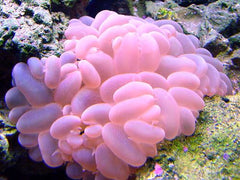 Although these corals are different species, they are quite similar in appearance, care level and temperament. These corals prefer light current and do well in dim to moderate light. Bubble and Fox Corals need the addition of calcium, strontium, and other trace elements to the water to promote good health and they should be fed brine shrimp or micro-plankton weekly. These corals do not require heavy skimming or efficient water filtration. Colors vary from green, white, pink and yellow.
Although these corals are different species, they are quite similar in appearance, care level and temperament. These corals prefer light current and do well in dim to moderate light. Bubble and Fox Corals need the addition of calcium, strontium, and other trace elements to the water to promote good health and they should be fed brine shrimp or micro-plankton weekly. These corals do not require heavy skimming or efficient water filtration. Colors vary from green, white, pink and yellow.
7. Pineapple / Moon Corals (Favia / Favites): Also known as Brain Coral, Closed Brain Coral and Star Coral, these corals prefer bright lighting but can tolerate lower light levels. Favia prefer light current, and some Favites have been known to attach to substrate after several months. Favia should be fed a few squirts of brine shrimp at night when their feeding sweeper tentacles are extended, however be careful when placing Favites as they can sting surrounding corals at night with their sweeper tentacles. Colors vary from Green, Orange, Tan and Yellow.
Also known as Brain Coral, Closed Brain Coral and Star Coral, these corals prefer bright lighting but can tolerate lower light levels. Favia prefer light current, and some Favites have been known to attach to substrate after several months. Favia should be fed a few squirts of brine shrimp at night when their feeding sweeper tentacles are extended, however be careful when placing Favites as they can sting surrounding corals at night with their sweeper tentacles. Colors vary from Green, Orange, Tan and Yellow.
6. Colt / Finger Corals (Klyxum sp. / Cladiella):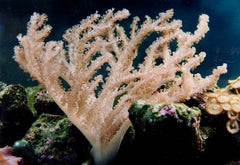 Also known as Finger Leather Corals, these corals are excellent beginner corals. They can adapt to almost any light and current conditions, however they prefer moderate lighting and current. The majority of its nutritional needs are met by the symbiotic algae zooxanthellae produced within its body using the process of photosynthesis. Colt Corals will also benefit from being fed micro-plankton, baby brine shrimp, and foods for filter feeding invertebrates. Color is almost always Brown, Tan, Beige.
Also known as Finger Leather Corals, these corals are excellent beginner corals. They can adapt to almost any light and current conditions, however they prefer moderate lighting and current. The majority of its nutritional needs are met by the symbiotic algae zooxanthellae produced within its body using the process of photosynthesis. Colt Corals will also benefit from being fed micro-plankton, baby brine shrimp, and foods for filter feeding invertebrates. Color is almost always Brown, Tan, Beige.
5. Leather / Toadstool Corals (Sarcophyton):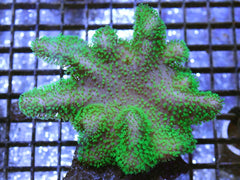 Also known as Mushroom Leather Coral and Trough Coral, these are fantastic corals for beginners because they adapt well to almost any lighting and respond well to low and moderate current levels. They require supplements of iodine, strontium, and other trace elements, and should be fed micro-plankton, baby brine shrimp, and foods for filter feeding invertebrates. Color varies from Yellow, Green, Tan and Brown. Sarcophyton corals will grow rapidly and are excellent for propagation.
Also known as Mushroom Leather Coral and Trough Coral, these are fantastic corals for beginners because they adapt well to almost any lighting and respond well to low and moderate current levels. They require supplements of iodine, strontium, and other trace elements, and should be fed micro-plankton, baby brine shrimp, and foods for filter feeding invertebrates. Color varies from Yellow, Green, Tan and Brown. Sarcophyton corals will grow rapidly and are excellent for propagation.
4. Mushroom Corals (Rhodactus / Actinodiscus):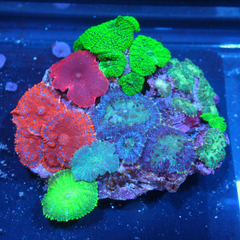 Also known as Mushroom Anemones, Disc Anemones, Fuzzy Mushrooms, these corals prefer low lighting, gentle water flow conditions, and should be placed near the bottom of the reef tank. Most of the nutritional needs are met by the symbiotic algae zooxanthellae produced within its body using the process of photosynthesis. Mushrooms will also benefit from being fed micro-plankton, and baby brine shrimp fed directly into the mouth or central disc opening. Mushrooms come in a wild array of colors, textures, and patterns, which is what makes them so popular with all reef hobbyists. There are entire user groups online dedicated to these coral gems that celebrate their endless diversity. Some are solid colors, such as orange, pink, purple, green, red and blue, whereas others are striped or spotted with any variation of color combinations. Given proper conditions Mushrooms will rapidly expand and dominate a large lower portion of your reef tank.
Also known as Mushroom Anemones, Disc Anemones, Fuzzy Mushrooms, these corals prefer low lighting, gentle water flow conditions, and should be placed near the bottom of the reef tank. Most of the nutritional needs are met by the symbiotic algae zooxanthellae produced within its body using the process of photosynthesis. Mushrooms will also benefit from being fed micro-plankton, and baby brine shrimp fed directly into the mouth or central disc opening. Mushrooms come in a wild array of colors, textures, and patterns, which is what makes them so popular with all reef hobbyists. There are entire user groups online dedicated to these coral gems that celebrate their endless diversity. Some are solid colors, such as orange, pink, purple, green, red and blue, whereas others are striped or spotted with any variation of color combinations. Given proper conditions Mushrooms will rapidly expand and dominate a large lower portion of your reef tank.
3. Button Polyp Corals (Palythoa / Protopalythoa):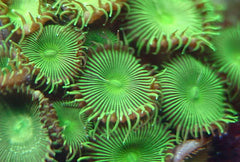 Also known as Moon Polyps, Encrusting Anemones, or Sea Mats, these colorful corals can tolerate low light, but prefer bright light and moderate to strong current. Button Polyps are very aggressive corals that reproduce rapidly. Some Paly species contain a strong neurotoxin (palytoxin) which can adversely affect humans when coming in contact with skin, so be sure to wear gloves when handling Button Polyps. They require supplements of iodine and trace elements, and should be fed weekly with micro-plankton and baby brine shrimp directly to it's tentacles. Colors are generally shades of brown, tan, or green and sometimes fluoresce under actinic lighting.
Also known as Moon Polyps, Encrusting Anemones, or Sea Mats, these colorful corals can tolerate low light, but prefer bright light and moderate to strong current. Button Polyps are very aggressive corals that reproduce rapidly. Some Paly species contain a strong neurotoxin (palytoxin) which can adversely affect humans when coming in contact with skin, so be sure to wear gloves when handling Button Polyps. They require supplements of iodine and trace elements, and should be fed weekly with micro-plankton and baby brine shrimp directly to it's tentacles. Colors are generally shades of brown, tan, or green and sometimes fluoresce under actinic lighting.
2. Green Star Polyp Corals (Briareum sp.):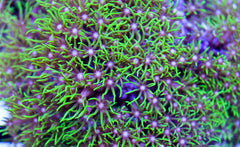 Also known as Star Polyps and Daisy Polyps, these corals can tolerant a wide range of both light levels and a range of currents, however they do very well under direct intense, bright light and strong direct current. Green Star Polyps spread very fast, and can easily overgrow other corals and spread to all areas of the tank including walls, returns, etc. They require supplements of iodine and trace elements, and should be fed micro-plankton and foods for filter feeding invertebrates. Colors vary from brown or green tentacles with a white central disc, to green tentacles with a green central disc.
Also known as Star Polyps and Daisy Polyps, these corals can tolerant a wide range of both light levels and a range of currents, however they do very well under direct intense, bright light and strong direct current. Green Star Polyps spread very fast, and can easily overgrow other corals and spread to all areas of the tank including walls, returns, etc. They require supplements of iodine and trace elements, and should be fed micro-plankton and foods for filter feeding invertebrates. Colors vary from brown or green tentacles with a white central disc, to green tentacles with a green central disc.
1. Zoas / Zoanthid Corals (Zoanthus):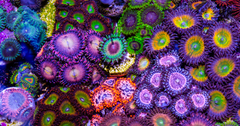 Zoas are colorful corals that can tolerate low light, but prefer moderate light and currents. Zoas can reproduce rapidly if given proper conditions. Some Zoanthus species contain a strong neurotoxin (palytoxin) which can adversely affect humans when coming in contact with skin, so be sure to wear gloves when handling Zoanthid Polyps. They require supplements of iodine and trace elements, and should be fed micro-plankton and baby brine shrimp directly to it's tentacles. Zoanthids come in a wild array of colors, textures, and patterns, which is what makes them so popular with all reef hobbyists. There are entire user groups online dedicated to these coral gems that celebrate their endless diversity. Some are solid colors, such as pink, yellow, orange, purple, green, red or blue, whereas others are striped or spotted with any variation of multiple color combinations. Given proper conditions Zoas will rapidly expand and dominate a large portion of your reef tank.
Zoas are colorful corals that can tolerate low light, but prefer moderate light and currents. Zoas can reproduce rapidly if given proper conditions. Some Zoanthus species contain a strong neurotoxin (palytoxin) which can adversely affect humans when coming in contact with skin, so be sure to wear gloves when handling Zoanthid Polyps. They require supplements of iodine and trace elements, and should be fed micro-plankton and baby brine shrimp directly to it's tentacles. Zoanthids come in a wild array of colors, textures, and patterns, which is what makes them so popular with all reef hobbyists. There are entire user groups online dedicated to these coral gems that celebrate their endless diversity. Some are solid colors, such as pink, yellow, orange, purple, green, red or blue, whereas others are striped or spotted with any variation of multiple color combinations. Given proper conditions Zoas will rapidly expand and dominate a large portion of your reef tank.
